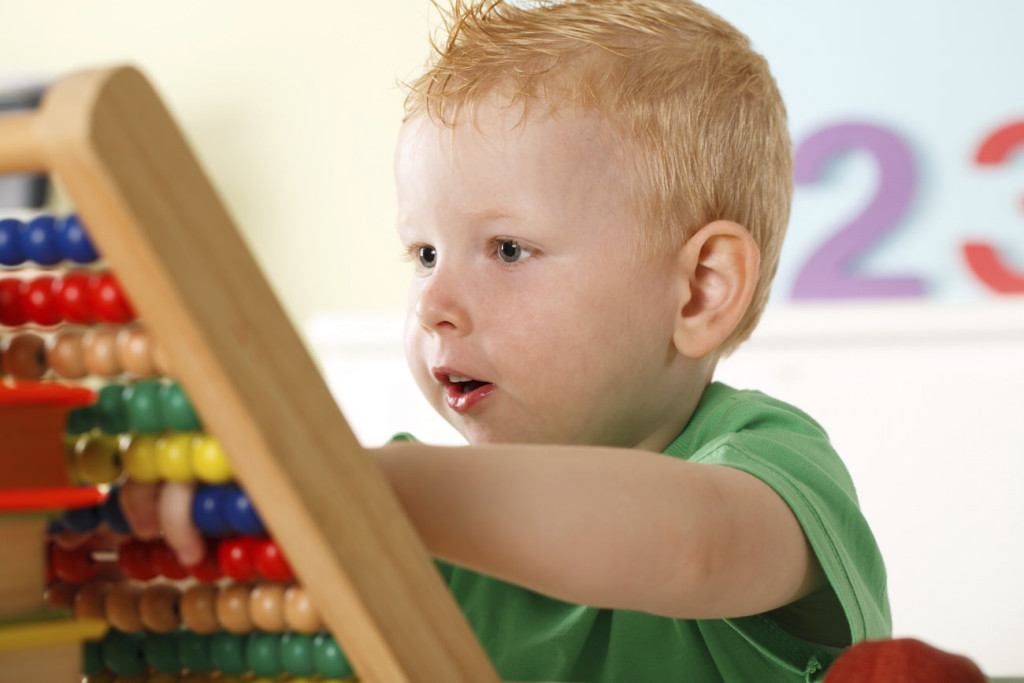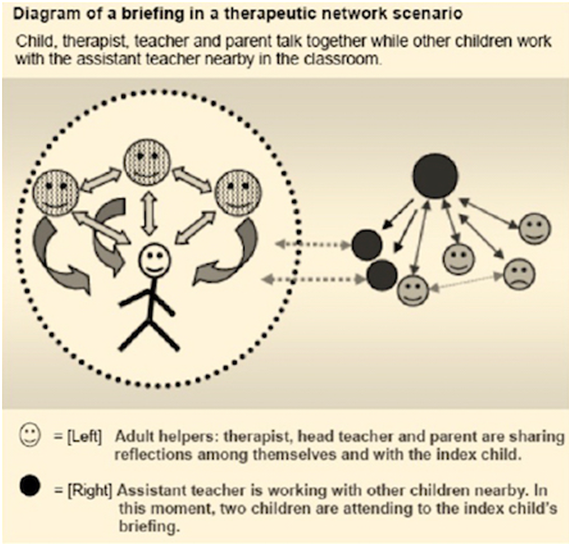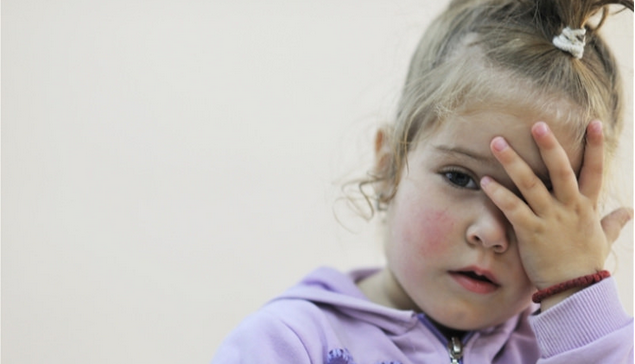Reflective Network Therapy is a deliberately synergistic combination of preschool education with in-classroom psychological treatment for emotionally and developmentally disordered children who are two to seven years old. The method is carried out by a network that includes a psychodynamically-trained therapist, teachers, children’s peers and family members. Intensive psychotherapy takes place exclusively within the learning and play activities of the classroom, focusing on one child at a time. Children with mild to moderate autism, serious emotional disorders, behavior problems as well as children with other or multiple diagnoses routinely achieve mental health gains, develop cognitively and become able to transition successfully into regular public school classrooms after treatment. Children are never pulled out of class for individual therapy; it takes place right in the classroom. The child’s here-and-now feelings, behavior, symbolic expressions and responses to other children and classroom events are all opportunities for therapeutic action and become the subjects of in-classroom therapy sessions.
This section describes some unique aspects of Reflective Network Therapy, and shows how interpersonal exercises can occur hundreds of times in a school year. It is versatile. We have found that these exercises are well suited to influence the brain and mind of an autism spectrum disordered child as well as the brain and mind of a child with a serious emotional disorder. Rich activation of the mirror neuron systems in the child patients treated by this method may account for their measurable IQ rises and mental health gains.
Reflective Network Therapy is an evidence-based psychological treatment method. RNT outcomes have been published in peer-reviewed journals. It harnesses small social networks to help individual children within real life spaces, such as preschools. It works for traumatized young children, as well as those with mild to moderate psychiatric disorders and autism spectrum disorders. Young children we have helped have most commonly presented with: autism spectrum disorders, attention deficit disorders, reactive attachment disorder, oppositional defiant disorder, post traumatic stress disorder, anxiety disorders and depressive disorders.
The small social network therapeutically activated by RNT is comprised of a classroom team of parents, normal children in the classroom, child pupils who are patients, their classroom teachers and a classroom therapist. This interactive network is dynamically engaged with each child, one at a time in the classroom, every day the class meets. The network’s intersubjective reflections organize and semantically encode each participant’s theory of the child’s own mind and to some extent of the minds of all the others in the classroom.
The child’s classroom peers are a vibrant part of this network. Everything happens in the real life space of the classroom, and takes advantage of what comes up between and among the children both as educational and therapeutic opportunities for growth. RNT techniques include: individualized psychotherapy sessions for each child right in the classroom; teacher to therapist briefings before each therapy session and therapist to teacher debriefings after each therapy session. Each briefing and debriefing enlists the child patient’s participation. Parent involvement is supported by weekly parent guidance. The child is not pulled out for psychotherapy. In no other method does the child’s treatment take place exclusively within the learning and play activities of their classroom groups.
The RNT preschool classroom is a uniquely psychoanalytically informative instrument for the psyhotherapeutic processes. Unlike pull out therapy in which a child is removed from real life space for individual therapy, RNT is deeply integrated into the child’s learning space as an interactive social setting. Everything takes place within the learning and play activities of the classroom an early childhood educational process and classroom group.
Every day, the treatment team takes advantage of many opportunities to consider immediate evidence of the child patient’s emotional and cognitive deficits, strengths and symptomology. Indicators of distress, acting-out, impending crisis, conflict, resistance and transference are psychotherapeutically addressed when they occur. During frequent psychotherapy sessions conducted within the preschool classroom, the child patient’s on the spot expressions, behaviors, interactions with others, her or his interest in and use of objects during play, responses to stimuli, and current emotional states are responded to in the moment.
 The method has regularly produced rapid mental health gains for seriously disturbed, developmentally delayed and traumatized young children. Gains include positive behavioral changes, improved relational skills, and substantially expanded learning capacity. These are reflected in the CGAS or Child’s Global Assessment Score. Even more objective are resulting rises in IQ. Regardless of diagnosis, statistically significant IQ rises occur routinely.
The method has regularly produced rapid mental health gains for seriously disturbed, developmentally delayed and traumatized young children. Gains include positive behavioral changes, improved relational skills, and substantially expanded learning capacity. These are reflected in the CGAS or Child’s Global Assessment Score. Even more objective are resulting rises in IQ. Regardless of diagnosis, statistically significant IQ rises occur routinely.
Each child pupil who is also a diagnosed patient is treated with parental permission and with the cooperation of his public or private school or day care center. Each child has a psychotherapy session every day of school, usually at least three times a week, right in the classroom, for 15-20 minutes. These short but frequent sessions go on within the classroom in the midst of classroom educational activities of all kinds. The sessions are witnessed, shared and inwardly or outwardly reflected on by everyone in the classroom, right in the real life space of the classroom, using the themes, symbolic expressions and behaviors which arise naturally in this setting.
The child’s psychotherapist intensely focuses on and attunes to each child in turn, for about a quarter an hour at a time. Empathic attunement by the therapist is responded to by the patient’s identification with that process. During that attunement, the therapist offers interpretations. Interpretations are the therapist’s tactful verbalization of her or his own reflections about the child’s feelings, and behavior, especially the therapist’s thoughts about what the child is doing and thinking in the here and now of the classroom, and what has caused those actions and thoughts.
Children’s resistances to education, refusal of affection, and inhibited or inappropriate socialization are interpreted on the spot, to the full extent the psychotherapist finds useful. The content of the therapy sessions varies as greatly as the individual children vary. Content may include a full range of psychoanalytically useful material such as talk, play, fantasies, dreams, interpersonal dramas, art work, responses and the therapist’s verbalized explanation of the meaning of a the child patient’s remarks, dreams, memories, experiences, and behavior (interpretations). If other children show interest, they can participate in all aspects of an index child’s session, provided they allow that child to lead the play and talk. Parents are often in the classroom and are welcome for the periods the parent’s presence allows and promotes the child’s use of the process.
At least two times each day, each child hears directly from the network of helping adults what they think and understand about what is happening in the child’s behavior and play. Adult conversations about a child patient in the classroom are done in the child’s presence.
The network reflects about the child in predictable and specific ways, including joint adult-child briefings and debriefings before and after each therapy session and at other spontaneously arising times throughout the classroom day. These conversations are structured around the natural events of the classroom. From these conversations, the child patient learns something about how others think about her or him and what she/he expresses or does. This creates multiple daily opportunities for the child to exercise and develop the capacity to independently reflect on her or his own thoughts, feelings and actions.

Reflective Network Therapy briefings are a structured sequence of interactive reflective and empathy-developing communications given during conversations. The child patient is encouraged to be an active participant in every briefing:
- When a child is brought to school each day, parents take a moment to brief the teacher. This briefing informs the treatment team about what might preoccupy the child before engaging in schoolwork and psychotherapy on that day. They might mention new events in the child’s life, any current behavior or something the child recently expressed.
- Before a child’s therapy session, the teacher and child brief the therapist about what the child and family have been doing. Parents also participate in this briefing when they are present. The adults might comment on an interaction just observed between the child and other children in the class. The constant daily briefings before in-classroom individual therapy sessions immediately augment the therapist’s access to important themes and behaviors based on the teachers’ observations.
- After the 15-20 minutes of individual therapy, the child and therapist close with a debriefing. Together they tell the teacher together about the contents of the psychotherapy session.
Teachers expand the psychotherapist’s horizons. The teachers and therapists meet as a team for 90 minutes each week, often viewing a recent videotape of their work, and always sharing the teachers’ many hours of classroom behavioral observation. The teachers are expected to greatly amplify the knowledge the therapist gains in the daily therapy sessions.
Parents are essential to the treatment. They are encouraged to be in the classroom, especially, but not only, during the early weeks of a child’s treatment. Parents regularly receive a 45 minute guidance session in private with the head or assistant teacher each week except that once a month their parent conference is with their child’s RNT therapist. This guidance conference includes the opportunity to give and get feedback about the child’s current behaviors, preoccupations and progress. One-on-one behavioral aides are not used. However, a child’s existing aide is welcome to come at the beginning of a child’s treatment. Behavioral aides are rarely required after a few days. In preschool classrooms where all the pupils are patients, six to twelve children work best, with one therapist and usually two teachers for six or eight special needs children. The adults in the classroom include one therapist and one head teacher with one teacher’s aide.


